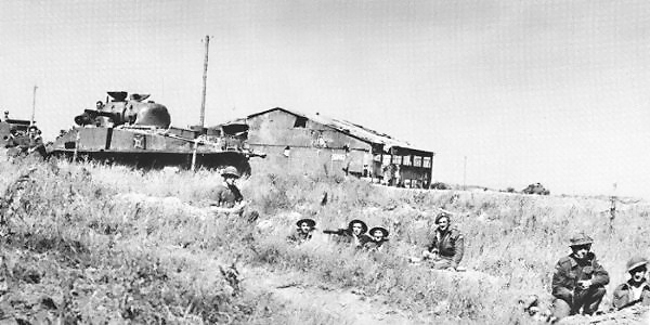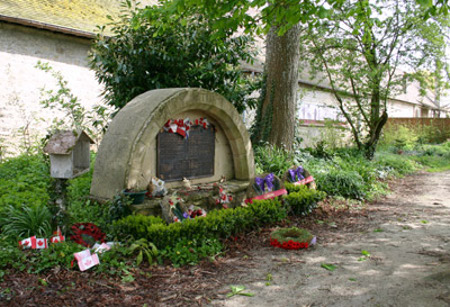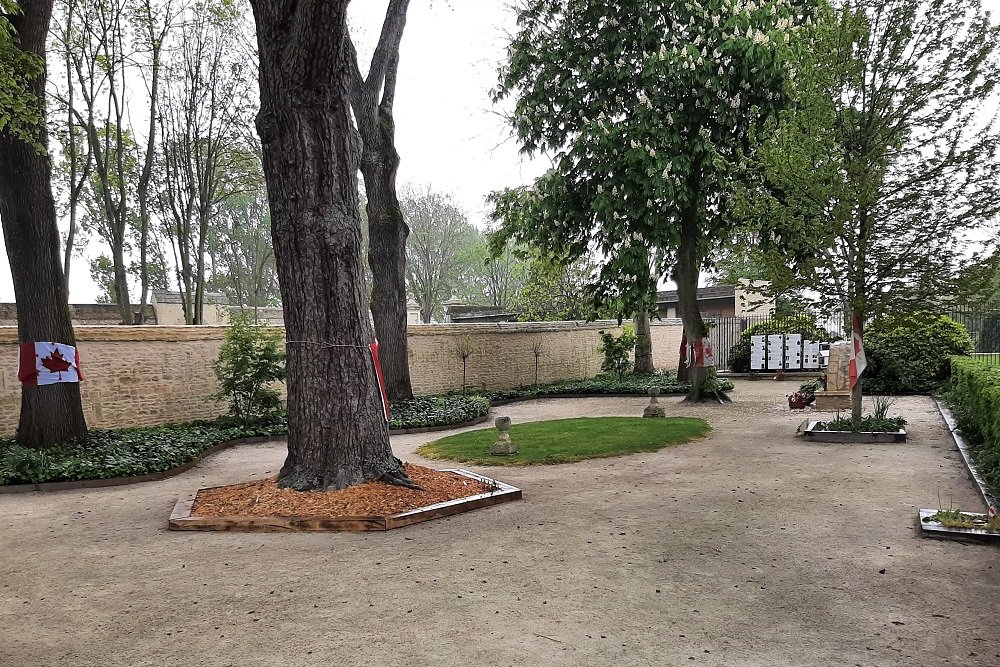The Canadian advance
SS-Standartenführer Kurt Meyer, commanding officer of the 25. SS-Panzergrenadier-Regiment
Introduction
On 7 June 1944, a day after the D Day landings, the Canadian units were still on their way to their original targets of the day before, which were the Caen-Bayeux road and the airfield of Carpiquet just beyond the road. During their advance to the airfield, named Carpiquet after the nearby village, these troops encountered fierce resistance from the German 12. SS-Panzer-Division "Hitlerjugend". It was the 25. SS-Panzergrenadier-Regiment from this division, commanded by Kurt Meyer, that had taken upon itself the defence of the area between the landing beaches and the airfield.
The Canadian landings
The 9th Brigade of the Canadian 3rd Infantry Division (under command of Major-General Rodney Keller) was due to land on Juno Beach late in de morning of 6 June. The brigade had to advance through the lines of units from 7th and 8th Brigade of the same division that had stormed the beach that morning.The 9th Brigade was commanded by Brigadier Douglas Cunningham and consisted of three regiments: The Highland Light Infantry of Canada (Lieutenant-Colonel F. M. Griffiths), The Stormont, Dundas and Glengarry Highlanders (Lieutenant-Colonel G. H. Christiansen) en The North Nova Scotia Highlanders (Lieutenant-Colonel C. Petch). The 27th Armoured Regiment, The Sherbrooke Fusiliers Regiment, under command of Lieutenant-Colonel M. B. K. Gordon, was the armoured support.
Around 11: 00 hour in the morning of 6 June General Keller decided to land the 9th Brigade. The unit was to land at St. Aubin and Bernières but the Navy had closed the beach in front of St. Aubin (Nan Red) because there was too much enemy fire. Because of this the entire brigade had to disembark at Bernières. Around 11:40 hour the first units landed there. However, due to traffic jams around Bernières it took until 16:00 hour before the first units advanced towards their rallying areas near Bény-sur-Mer.
From the rallying area near Bény-sur-Mer the brigade had to advance further through the lines of 7th Brigade to her objective for that day, the high grounds around the airfield of Carpiquet, right south to the road between Caen and Bayeux. At 18:20 hour the North Nova Scotia Highlanders and the Sherbrooke Fusiliers advanced together to Basly and Colomby-sur-Thaon. Both units reached Villons-les-Buissons around 20:00 hour where the Highlanders ran into heavy resistance from German units. The units dug in for the night for it was impossible to reach the airfield before dark.Besides this, most of the units from 9th Brigade were still spread out over the road between Bény-sur-Mer en Villons-les-Buissons. A counterattack from 21. Panzer-Division or 12. SS-Panzer-Division was suspected.
The German defence
The 25. SS-Panzergrenadier-Regiment (SS-Standartenführer Kurt Meyer) was a unit from the 12. SS-Panzer-Division "Hitlerjugend", under command of SS-Brigadeführer Fritz Witt, and was near Orbec just after midnight on 6 June. From here Meyer had ordered patrols in the direction of Caen. The division was not to be deployed without the strict permission of Adolf Hitler(OKW). Just after 05:00 hour the division was assigned to the LXXXIV Armeekorps as part of Heeresgruppe B. At 05:45 hour OB West, Supreme Commander West, agreed to a request of Heeresgruppe B to concentrate the division around Lisieux. Around 15:00 hour the Hitlerjugend- and Panzer Lehr-divisions were assigned to the I. SS-Panzerkorps (under command of SS-Obergruppenführer Josef Dietrich) that resorted under the 7.Armee within Heeresgruppe B. Around 17:40 hour Meyer heard that Dietrich and Witt had decided to send his regiment to Evrecy. It took until late that night before most of the units had arrived. These delays ensured that the 25. SS-Panzergrenadier-Regiment could mount its first counterattack only on 7 June.
On 7 June a large German counterattack was planned that was to be executed by 12.SS-Panzer-Division and the 21. Panzer-Division (under command of Generalmajor Edgar Feuchtinger). This counterattack was intended to destroy the allied units that had landed on Juno and Sword beaches.The 12. SS Hitlerjugend division was to attack west and the 21. Panzer-Division would attack east of the railroad running between Caen and Luc-sur-Mer. This attack was scheduled for 16:00 hour on 7 June. The easternmost units of Hitlerjugend had not reached beyond the line Verson-Rots. The 21st Panzer-Division had her most western units deployed around Epron. There remained a large gap between the two divisions, filled only with the remnants of the 716. Infanterie Division, under command of Generalleutnant Wilhelm Richter. Around midnight Meyer met Richter and Feuchtinger in the command post of the 716.Infanterie-Division. Feuchtinger thought that the village and airfield of Carpiquet already had been captured by the Canadians. Meyer subsequently sent reconnaissance units in order to see for himself how the situation in the area really was. These units reported that Carpiquet, Rots en Buron were free from enemy troops but that Les Buissons already had been taken (by units from The North Nova Scotia Highlanders). Here and there small units from the 716. Infanterie-Division were encountered.
Just before Meyer left, his divisional commander called him and ordered him to close the gap in the front and to avert the allies from reaching the strategic area of Carpiquet. Meyers 25. SS-Panzergrenadier-Regiment took up defensive positions following this call.The I. Bataillon commanded by SS-Sturmbannführer Hans Waldmüller, together with the 16. Pionier-(engineers)Kompanie (SS-Obersturmführer Werner) took up positions around Epron and La Folie. The II. Bataillon lay in the vicinity of St. Contest and Bitot. At first it was commanded by SS-Sturmbannführer Hans Scappini, but after he died on the 7th he was replaced by SS-Hauptsturmführer Heinz Schrott. The III. Bataillon, commanded by SS-Sturmbannführer Karl-Heinz Milius had not yet arrived, but was to take up positions on the road from Caen and Bayeux southeast of Franqueville.
Meyer placed his own command post in the Abbaye d'Ardenne, on the road between Authie and St. Germain-la-Blanche-Herbe, just south of Cussy. This abbey consisted among others of a church with two towers in an orchard with a thick protective wall around it. The towers were ideally suited as observation posts for Meyer and his artillery. SS-Obersturmbannführer Max Wünsche of the 12. SS-Panzer-Regiment as well as SS-Sturmbannführer Karl Bartling of the III. Bataillon of the 12. SS-Panzerartillerie-Regiment had set up their respective headquarters in the abbey.
Around 10:00 hour the II. Bataillon of the 12. SS-Panzer-Regiment, commanded by SS -Sturmbannführer Karl-Heinz Prinz, arrived in the area. Many other units of the 12th SS armoured divisiondivisie ,however, had not arrived yet. The I. Bataillon of the12. SS-Panzer-Regiment (SS-Sturmbannführer Arnold Jürgensen) was stuck without fuel east of the river Orne and the 26. SS-Panzergrenadier-Regiment (commanded by SS-Oberführer Wilhelm Mohnke) and several artillery units still had to cross the river Odon, a river south of the road Villers-Bocage – Caen. The II. Bataillon of Prinz was equipped with PzKpfw IV's spread out over five companies. The 5.Kompanie was assigned to the III. Bataillon of the 25. SS-Panzergrenadier-Regiment near Franqueville. The 6. and 7. Kompanie were positioned on both sides of the abbey.The 8. Kompanie was sent towards the area of the I. Bataillon from the 25. SS-Panzergrenadier-Regiment at Epron. The 9. Kompanie of the regiment was kept in reserve behind the 5. Kompanie . This was probably in the vicinity of the airfield of Carpiquet. The units now had to wait for the arrival of the rest of the 12. SS-Panzer-Division and the start of the counteroffensive at 16:00 hour.
Definitielijst
- Armee
- German unit. Mostly consisted of three to six army corps and other subordinate or independent units. An Armee was subject to a Heeresgruppe or Armeegruppe and had in theory 60,000-100,000 men.
- Bocage
- The characteristic Normandy landscape with hedges. After D-Day this landscape causes the Allied forces much delay and casualties, because the hedges were easy to defend and had to be taken one by one from the Germans.
- Brigade
- Consisted mostly of two or more regiments. Could operate independently or as part of a division. Sometimes they were part of a corps instead of a division. In theory a brigade consisted of 5,000 to 7,000 men.
- Heeresgruppe
- The largest German ground formation and was directly subordinate to the OKH. Mainly consisting of a number of “Armeen” with few directly subordinate other units. A Heeresgruppe operated in a large area and could number several 100,000 men.
- Infantry
- Foot soldiers of a given army.
- OKW
- “Oberkommando der Wehrmacht”. German supreme command of the Armed Forces, Army, Air Force and Navy.
- Regiment
- Part of a division. A division divided into a number of regiments. In the army traditionally the name of the major organised unit of one type of weapon.
- resistance
- Resistance against the enemy. Often also with armed resources.
Images
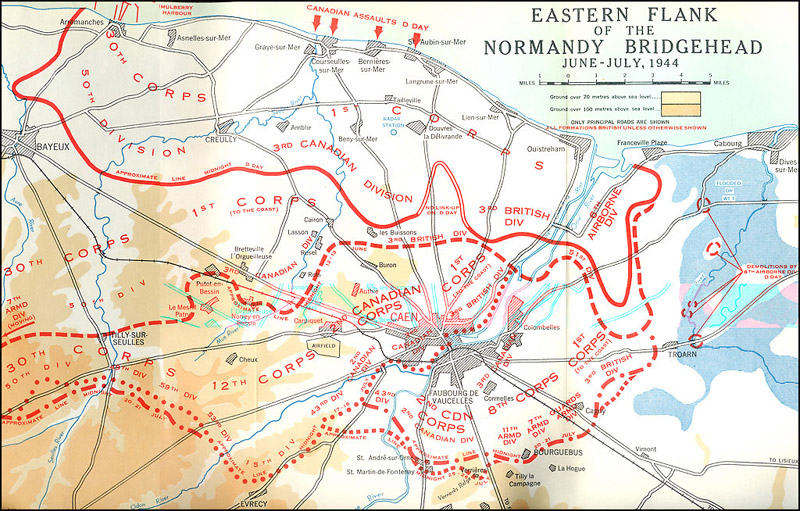 The battle area around Caen and Carpiquet. Source: HyperWar.
The battle area around Caen and Carpiquet. Source: HyperWar.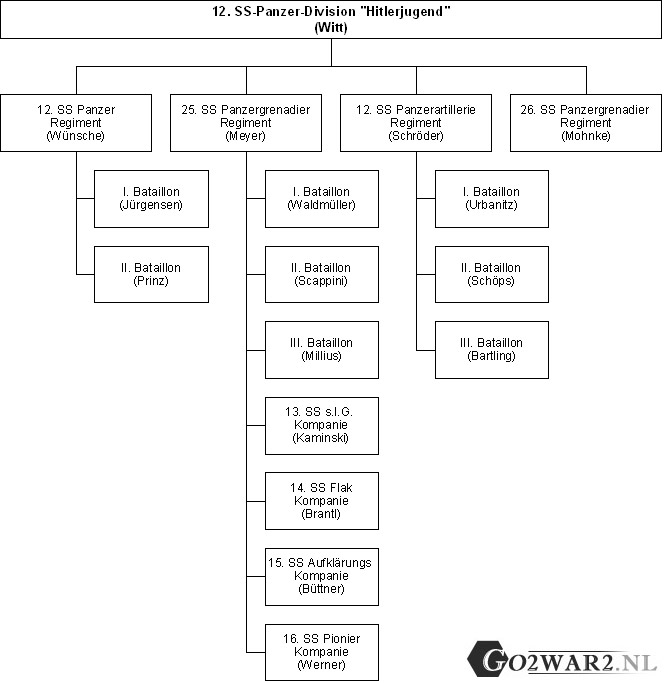 Units from the 12. SS-Panzer-Division "Hitlerjugend". Source: Go2War2.nl.
Units from the 12. SS-Panzer-Division "Hitlerjugend". Source: Go2War2.nl.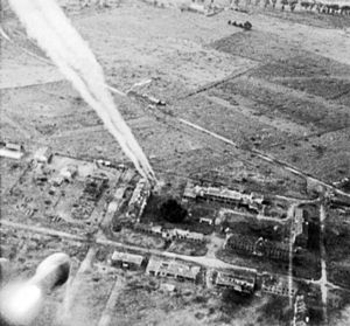 Rockets fired from a Hawker Typhoon of No 181 Squadron, RAF, at buildings on Carpiquet airfield. Source: Wikipedia.
Rockets fired from a Hawker Typhoon of No 181 Squadron, RAF, at buildings on Carpiquet airfield. Source: Wikipedia.The Canadian advance resumed
The Canadian 9th Brigade had, in the meantime, resumed her advance at 07:45 uur. Stuart light tanks drove in front, followed by C Company of the North Nova Scotia Highlanders in Bren carriers, followed by the rest of the regiment on the Sherman tanks of the Sherbrooke Fusiliers. The target was the airfield of Carpiquet. The Canadians came under fire rather quickly from the area of Villons-les-Buissons. The village was cleared of Germans at 09:00 hour. Arond 11:50 hour Buron was reached and an anti tank gun was knocked out.At 13:00 uur C Company reached Authie; the Stuarts were by then near Franqueville. It was at this moment that Kurt Meyer saw the Sherman that stopped in the orchard of St. Contest.
The tank was positioned there in order to protect the flank of the advance towards the airfield. Many tanks advanced from Buron towards Authie, parallel to the front of the II. Bataillon of the 25. SS-Panzergrenadier-Regiment. Meyer decided to refrain from the planned counterattack at 16:00 hour and he ordered his men to wait for his sign to open fire. As soon as the first tanks passed Franqueville he ordered Wünsche to attack. Soon the first Sherman tanks were hit. The battle started. The Canadian infantry tried to pull back to Authie but Meyers III Bataillon arrived first. Soon Franqueville and Authie were retaken by the Germans.South of Buron the tanks from the Sherbrooke Fusiliers and the PzKpfw IV's of the12. SS-Panzer-Regiment clashed.
The II. Bataillon of the 25. SS-Panzergrenadier-Regiment,in the meantime, had joined the attacking troops towards Buron together with the tanks from the 7. Panzer-Kompanie. St. Contest quickly fell. The commander of the battalion,Scappini, paused here for a short while in order to let the left flank link up with the right flank. He consulted shortly with his staff. Meyer was here also.The group was attacked by three Canadian tanks.Scappini was mortally wounded in this action.He was prompty replaced by Schrott. Subsequently the tanks were pushed back and the hamlets of Malon and Galmanche were captured with only resistance from artillery fire. Buron fell in the late afternoon and Gruchy was also quickly retaken by the Germans. Cunningham then decided to pull back the remaining units of his brigade to their jump off positions around Villons-les-Buissons.
In the meantime, at 16:15 hour, the I. Bataillon of the 25.SS-Panzergrenadier-Regiment, supported by the 16. Pionier-Bataillon of the 25. SS-Panzergrenadier-Regiment and the PzKpfw IV's of the 8. Kompanie (II. Bataillon of the 12. SS-Panzer-Regiment) started their advance towards Anguerny. Around Cambes-en-Plaine however they ran into the 2nd Batallion of the Royal Ulster Rifles. This unit was part of the British 9th Brigade that had landed on Sword Beach the day before and was subordinated to the British 3rd Infantry Division. The five tanks of the 8. Kompanie encountered Shermans of the 1st East Riding Yeomanry and were all knocked out. Only two of them were defeated by fire however, a third had to pull back due to mechanical problems, another one got stuck in a giant shell hole and the fifth was put out of action by a razed tree trunk. Despite the lack of armoured support the Germans managed to push the British back to the Bois du Mesnil.
Meyers flanks in the meantime were in the air now and the 21. Panzer-Division could not secure the right flank. Meyer decided not to advance any further. As it grew dark the II. Bataillon of the12. SS-Panzer-Regiment, together with the Pionier-(engineer), Flak-(anti aircraft) and Aufklärungs(reconnaissance) Kompanien were between Gruchy, Authie and Franqueville. The III. Bataillon of the 25. SS-Panzergrenadier-Regiment was in Buron, the II. Bataillon of the 25. SS-Panzergrenadier-Regiment in Galmanche (a hamlet north of St. Contest and southwest of Cambes-en-Plaine) and the I. Bataillon of the 25. SS-Panzergrenadier-Regiment was in Cambes-en-Plaine.
Aftermath
The Canadian advance towards Caen and Carpiquet had been brought to a standstill. The Canadians and Germans lost many tanks and men during the fighting. It would take another month before the allies were to capture these areas.During operation Windsor the Canadians from Kellers 3rd Infantry Division would once more attack the village and the airfield of Carpiquet. This time they would be successful.
Meyer was taken prisoner in September, 1944 in Belgium. He was brought before trial after the war for the execution of Canadian soldiers on 7 June 1944 at his headquarters, the Abbaye d'Ardenne. Meyer was charged among other things for his alleged responsibility for executing 11 Canadian POWs on 7 Juni and for ordering, or being responsible for the execution of 7 Canadian soldiers on 8 June. He was not convicted for giving the order but he was convicted for being responsible, as well as for ordering his troops to deny quarter for the prisoners and was therefore sentenced to death. This was later commuted to a life sentence. In the fifties the verdict was changed again and in 1954 Meyer was released.Meyer died in 1961 on the age of 51.
Definitielijst
- Batallion
- Part of a regiment composed of several companies. In theory a batallion consists of 500-1,000 men.
- Brigade
- Consisted mostly of two or more regiments. Could operate independently or as part of a division. Sometimes they were part of a corps instead of a division. In theory a brigade consisted of 5,000 to 7,000 men.
- Flak
- Flieger-/Flugabwehrkanone. German anti-aircraft guns.
- infantry
- Foot soldiers of a given army.
- regiment
- Part of a division. A division divided into a number of regiments. In the army traditionally the name of the major organised unit of one type of weapon.
- resistance
- Resistance against the enemy. Often also with armed resources.
Images
Information
- Article by:
- Jeroen Koppes
- Translated by:
- Peter ter Haar
- Published on:
- 12-07-2015
- Last edit on:
- 30-09-2024
- Feedback?
- Send it!
Related sights
Related books
Sources
- CARELL, P., Invasion! They're Coming!, Schiffer Publishing, Atglen, PA, USA, 1995.
- FOWLER, W., D-Day, the first 24 hours, Amber Books, London, UK, 2003.
- LEFèVRE, E., Panzers in Normandy, After The Battle, London, UK, 1983.
- MCANDREW, B. e.a., Normandy 1944, Éditions Art Global, Montreal, Canada, 1994.
- MEYER, H., The 12th SS (volume one), Stackpole Books, Mechanicsburg, PA, USA, 2005.
- MEYER, H., The 12th SS (volume two), Stackpole Books, Mechanicsburg, PA, USA, 2005.
- MEYER, K., Grenadiers: The Story Of Waffen SS General Kurt 'Panzer' Meyer, Stackpole Military History, 2005.
- RAMSEY, W.G. e.a., D-Day, After the Battle, London, UK, 1995.
- REYNOLDS, M., Steel Inferno, Dell Publishing, New York, 1997.
- D-Day - Operation Overlord - Landings and Battle of Normandy
- Special Camp: XI - Pows held at Bridgend
- Norwegians in the Waffen-SS 1941-45
- The 12. SS-Panzerdivision "Hitlerjugend"
- Web Genocide Documentation Centre
- Abbaye d'Ardenne en normandie 1944
- The Valour and the Horror
- Juno Beach - The Canadians On D-Day
- Generals of World War II
- Feldgrau.com
- Axis History Factbook
- Wikipedia.org
